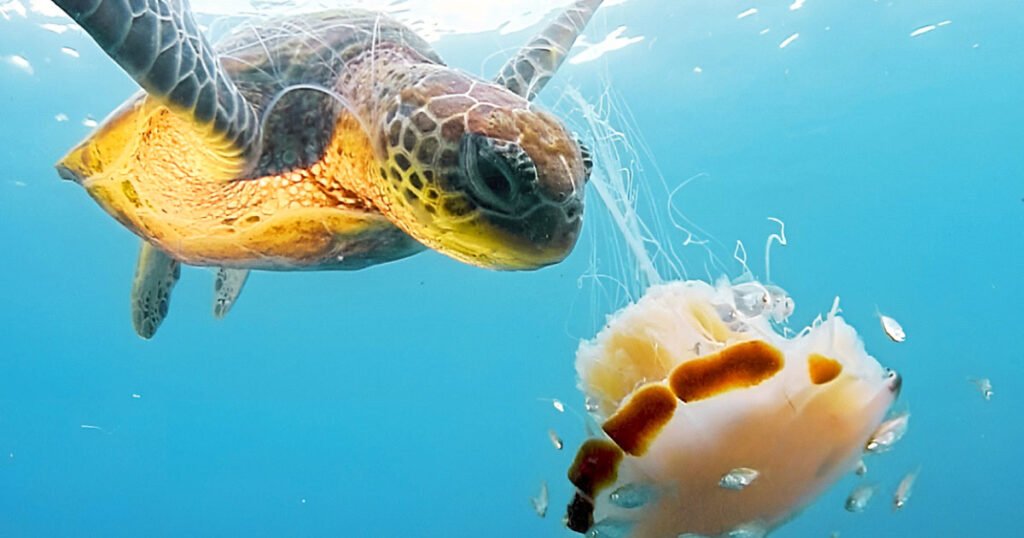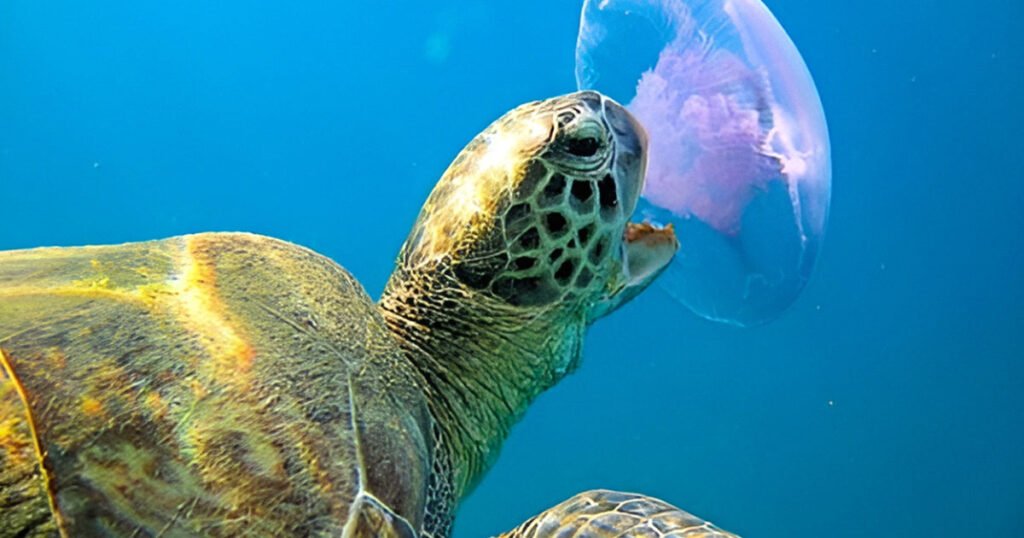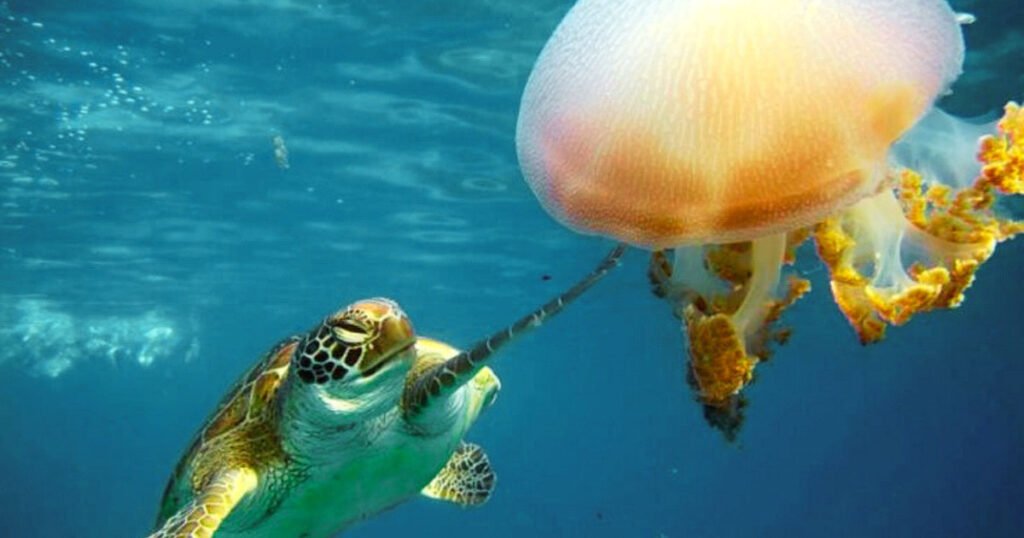Sometimes, funny myths become widespread on the internet. One such myth claims that jellyfish cause turtles to experience a marijuana-like high, particularly sea turtles. So, do jellyfish make sea turtles high?
Crush, the sea turtle in Finding Nemo, is known for his laid-back personality and surfer-like speech. Crush’s relaxed nature has contributed to the myth that sea turtles get high after eating jellyfish.
So, is there any truth to this quirky tale about “Do jellyfish make sea turtles high?” Let’s dive in.
Do Jellyfish Make Turtles High?

No, they can’t! The rumor floats around the internet, but it’s not true.
Jellyfish are a big part of turtle diets because they are more available for them to eat. All seven species of sea turtles eat jellyfish. However, the toxins in jellyfish don’t have any effect that would intoxicate a turtle.
Just think about it this way: jellyfish stings might hurt us or any other species, but turtles are totally immune to them! So, those jellyfish snacks don’t cause any high, just a full and happy turtle tummy.
Do Turtles Eat Jellyfish?

Yes, turtles eat jellyfish from their underwater surroundings. In fact, jellyfish are a delicious treat for some turtles, especially sea turtles. With all those calories packed into a jellyfish snack, a turtle might feel a little surge of energy—like a natural sugar rush.
But it’s not the same as getting high. It’s just their body responding to all that yummy jellyfish fuel. Few predators eat jellyfish other than sea turtles. For some turtle species, like the mighty leatherback sea turtle, jellyfish are their main course.
Just like their land-dwelling cousins, who might gobble up worms and bugs, sea turtles are opportunistic eaters. They’ll take advantage of easy meals, and jellyfish are slow-moving and plentiful in the ocean, so they are a perfect target for a hungry sea turtle.
Why it is Said that Jellyfish Can be Toxic?
Some jellyfish pack a punch with a toxin called tetrodotoxin, potent enough to paralyze or even kill other animals. But sea turtles have a superpower – they’re safe from this nasty toxin! They can munch on jellyfish all day without feeling a thing.
So, do the chemicals in jellyfish make sea turtles high? Again, the absolute answer is not. There is not even any evidence from research to prove this fact.
How Do Sea Turtles Eat Jellyfish to Avoid Stinging?

Imagine this: a giant sea turtle happily chewing on a jellyfish. If you know about jellyfish’s toxic sting, then it sounds strange. After all, jellyfish are known for their stinging power.
But here’s the truth: sea turtles have developed some incredible adaptations that allow them to enjoy these gelatinous snacks without getting stung!
Thick Shells Provide Protection
First of all, sea turtles have tough shells made of bony plates covered in a thick layer of skin. This shell acts like a suit of armor, deflecting the stinging barbs of jellyfish—it’s like wearing a super strong shield for every meal!
Sharp Beak Adaptation
Unlike their freshwater cousins, who have soft beaks, sea turtles have sharp, beak-like mouths used for tearing through jellyfish. The skin around their beaks is thick enough to withstand accidental stings.
Blind Attack Strategy
Sea turtles use a blind attack strategy when hunting jellyfish. This might seem risky, but they have a special eyelid called a nictitating membrane that lets them see through it, like a built-in blindfold for safe jellyfish devouring.
They swim towards the jellyfish with their mouths open, close their eyes at the last moment, and strike the prey without getting stung.
Papillae in Their Mouths
The fun doesn’t stop there! Inside their mouths, sea turtles have tiny, spiky things called papillae. These papillae act like a double defense – they help grab and hold onto the jellyfish’s food.
It also creates a barrier between the jellyfish and the turtle’s more delicate tissues, like their tongue. Think of them as tiny built-in gloves that both grip the food and protect the turtle’s mouth from getting stung.
Particular Adaptations for Leatherbacks
Leatherback sea turtles, the ultimate jellyfish hunter, have an extra trick up their sleeves (or rather, in their mouths!). They have specialized barbs on the roof of their mouths that point backward, like tiny hooks.
These barbs help them hold onto their slippery jellyfish prey and prevent them from escaping while the turtle swallows them whole. It’s a one-way trip for the jellyfish and a safe and tasty snack for the leatherback.
So, the next time you see a picture of a sea turtle swimming near a jellyfish, don’t worry about them getting stung. They’ve evolved adaptations that allow them to enjoy a unique and plentiful food source in the ocean.
Why Do Sea Turtles Eat Jellyfish?

Ever wonder why a giant sea turtle would choose a stinging jellyfish for a meal? There are actually a few reasons these unlikely pairs become underwater diners and lunch!
Easy Catch, Easy Snack
Jellyfish are kind of the couch potatoes of the ocean – they move slowly and don’t have any way to fight back. This makes them a perfect target for a hungry turtle looking for a quick and easy bite!
Nutritious
Believe it or not, jellyfish are like a healthy snack for sea turtles. They’re low in fat and full of protein, which helps keep turtles solid and healthy. Think of them as jellyfish protein shakes for these swimming athletes.
Iodine Power
Our bodies need vitamins and minerals to stay healthy, and sea turtles are no different. Jellyfish are a great source of iodine, which helps keep a turtle’s shell strong and healthy. It’s like built-in shell armor protection most of them get from jellyfish.
Most Available Food
If you’re looking for jellyfish in the ocean, you won’t have to look far. These guys are all over the place, from the tropics to the poles. This abundance means a reliable food source for sea turtles, no matter where they roam in the vast ocean.
So, the next time you see a sea turtle and a jellyfish, remember – it’s not an enemy encounter; it’s lunchtime! These underwater creatures have a fascinating relationship, and jellyfish play an essential role in keeping sea turtles healthy and strong.
FAQs
Do the chemicals in jellyfish make turtles high?
No. This is a fun myth, but it’s not true. Jellyfish chemicals don’t affect turtles that way. Sea turtles are even immune to the toxins that can sting humans.
Read More: Do Sea Turtles Migrate?
Bottom Line
So, the confusing question is: Do jellyfish make turtles high? The answer is an absolute no! We humans might be scared of jellyfish because of their sting, but these underwater turtles aren’t. For some sea turtle species, jellyfish are a tasty and nutritious snack that provides them with protein and minerals.
It’s more like a health food trip for turtles, not a crazy adventure. The next time you see a sea turtle cruising by, remember – they might be on the hunt for some delicious, jelly-good fuel.
